Reblogging This Manually. Op Doesn't Want Credit For Fear Of Being Terminated.

Reblogging this manually. Op doesn't want credit for fear of being terminated.
More Posts from Quail-dawn and Others
Words for Skin Tone | How to Describe Skin Color
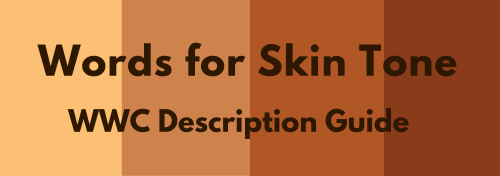
We discussed the issues describing People of Color by means of food in Part I of this guide, which brought rise to even more questions, mostly along the lines of “So, if food’s not an option, what can I use?” Well, I was just getting to that!
This final portion focuses on describing skin tone, with photo and passage examples provided throughout. I hope to cover everything from the use of straight-forward description to the more creatively-inclined, keeping in mind the questions we’ve received on this topic.
Standard Description
Basic Colors

Pictured above: Black, Brown, Beige, White, Pink.
“She had brown skin.”
This is a perfectly fine description that, while not providing the most detail, works well and will never become cliché.
Describing characters’ skin as simply brown or beige works on its own, though it’s not particularly telling just from the range in brown alone.
Complex Colors
These are more rarely used words that actually “mean” their color. Some of these have multiple meanings, so you’ll want to look into those to determine what other associations a word might have.

Pictured above: Umber, Sepia, Ochre, Russet, Terra-cotta, Gold, Tawny, Taupe, Khaki, Fawn.
Complex colors work well alone, though often pair well with a basic color in regards to narrowing down shade/tone.
For example: Golden brown, russet brown, tawny beige…
As some of these are on the “rare” side, sliding in a definition of the word within the sentence itself may help readers who are unfamiliar with the term visualize the color without seeking a dictionary.
“He was tall and slim, his skin a russet, reddish-brown.”
Comparisons to familiar colors or visuals are also helpful:
“His skin was an ochre color, much like the mellow-brown light that bathed the forest.”
Modifiers
Modifiers, often adjectives, make partial changes to a word.The following words are descriptors in reference to skin tone.
Dark - Deep - Rich - Cool
Warm - Medium - Tan
Fair - Light - Pale
Rich Black, Dark brown, Warm beige, Pale pink…
If you’re looking to get more specific than “brown,” modifiers narrow down shade further.
Keep in mind that these modifiers are not exactly colors.
As an already brown-skinned person, I get tan from a lot of sun and resultingly become a darker, deeper brown. I turn a pale, more yellow-brown in the winter.
While best used in combination with a color, I suppose words like “tan” “fair” and “light” do work alone; just note that tan is less likely to be taken for “naturally tan” and much more likely a tanned White person.
Calling someone “dark” as description on its own is offensive to some and also ambiguous. (See: Describing Skin as Dark)
Undertones
Undertones are the colors beneath the skin, seeing as skin isn’t just one even color but has more subdued tones within the dominating palette.
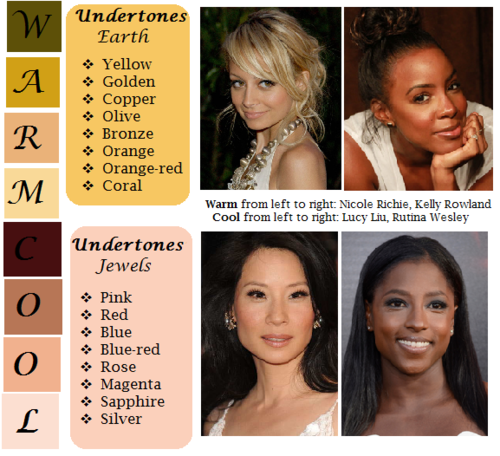
pictured above: warm / earth undertones: yellow, golden, copper, olive, bronze, orange, orange-red, coral | cool / jewel undertones: pink, red, blue, blue-red, rose, magenta, sapphire, silver.
Mentioning the undertones within a character’s skin is an even more precise way to denote skin tone.
As shown, there’s a difference between say, brown skin with warm orange-red undertones (Kelly Rowland) and brown skin with cool, jewel undertones (Rutina Wesley).
“A dazzling smile revealed the bronze glow at her cheeks.”
“He always looked as if he’d ran a mile, a constant tinge of pink under his tawny skin.”
Standard Description Passage
“Farah’s skin, always fawn, had burned and freckled under the summer’s sun. Even at the cusp of autumn, an uneven tan clung to her skin like burrs. So unlike the smooth, red-brown ochre of her mother, which the sun had richened to a blessing.”
-From my story “Where Summer Ends” featured in Strange Little Girls
Here the state of skin also gives insight on character.
Note my use of “fawn” in regards to multiple meaning and association. While fawn is a color, it’s also a small, timid deer, which describes this very traumatized character of mine perfectly.
Though I use standard descriptions of skin tone more in my writing, at the same time I’m no stranger to creative descriptions, and do enjoy the occasional artsy detail of a character.
Creative Description
Whether compared to night-cast rivers or day’s first light…I actually enjoy seeing Characters of Colors dressed in artful detail.
I’ve read loads of descriptions in my day of white characters and their “smooth rose-tinged ivory skin”, while the PoC, if there, are reduced to something from a candy bowl or a Starbucks drink, so to actually read of PoC described in lavish detail can be somewhat of a treat.
Still, be mindful when you get creative with your character descriptions. Too many frills can become purple-prose-like, so do what feels right for your writing when and where. Not every character or scene warrants a creative description, either. Especially if they’re not even a secondary character.
Using a combination of color descriptions from standard to creative is probably a better method than straight creative. But again, do what’s good for your tale.
Natural Settings - Sky

Pictured above: Harvest Moon -Twilight, Fall/Autumn Leaves, Clay, Desert/Sahara, Sunlight - Sunrise - Sunset - Afterglow - Dawn- Day- Daybreak, Field - Prairie - Wheat, Mountain/Cliff, Beach/Sand/Straw/Hay.
Now before you run off to compare your heroine’s skin to the harvest moon or a cliff side, think about the associations to your words.
When I think cliff, I think of jagged, perilous, rough. I hear sand and picture grainy, yet smooth. Calm. mellow.
So consider your character and what you see fit to compare them to.
Also consider whose perspective you’re describing them from. Someone describing a person they revere or admire may have a more pleasant, loftier description than someone who can’t stand the person.
“Her face was like the fire-gold glow of dawn, lifting my gaze, drawing me in.”
“She had a sandy complexion, smooth and tawny.”
Even creative descriptions tend to draw help from your standard words.
Flowers
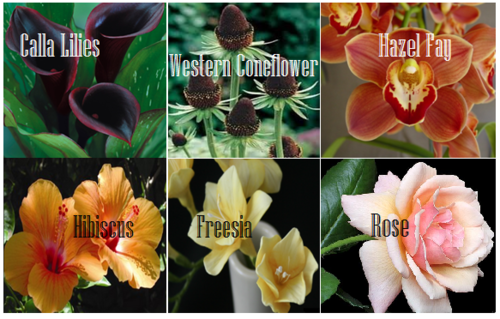
Pictured above: Calla lilies, Western Coneflower, Hazel Fay, Hibiscus, Freesia, Rose
It was a bit difficult to find flowers to my liking that didn’t have a 20 character name or wasn’t called something like “chocolate silk” so these are the finalists.
You’ll definitely want to avoid purple-prose here.
Also be aware of flowers that most might’ve never heard of. Roses are easy, as most know the look and coloring(s) of this plant. But Western coneflowers? Calla lilies? Maybe not so much.
“He entered the cottage in a huff, cheeks a blushing brown like the flowers Nana planted right under my window. Hazel Fay she called them, was it?”
Assorted Plants & Nature

Pictured above: Cattails, Seashell, Driftwood, Pinecone, Acorn, Amber
These ones are kinda odd. Perhaps because I’ve never seen these in comparison to skin tone, With the exception of amber.
At least they’re common enough that most may have an idea what you’re talking about at the mention of “pinecone."
I suggest reading out your sentences aloud to get a better feel of how it’ll sounds.
"Auburn hair swept past pointed ears, set around a face like an acorn both in shape and shade.”
I pictured some tree-dwelling being or person from a fantasy world in this example, which makes the comparison more appropriate.
I don’t suggest using a comparison just “cuz you can” but actually being thoughtful about what you’re comparing your character to and how it applies to your character and/or setting.
Wood

Pictured above: Mahogany, Walnut, Chestnut, Golden Oak, Ash
Wood can be an iffy description for skin tone. Not only due to several of them having “foody” terminology within their names, but again, associations.
Some people would prefer not to compare/be compared to wood at all, so get opinions, try it aloud, and make sure it’s appropriate to the character if you do use it.
“The old warlock’s skin was a deep shade of mahogany, his stare serious and firm as it held mine.”
Metals

Pictured above: Platinum, Copper, Brass, Gold, Bronze
Copper skin, brass-colored skin, golden skin…
I’ve even heard variations of these used before by comparison to an object of the same properties/coloring, such as penny for copper.
These also work well with modifiers.
“The dress of fine white silks popped against the deep bronze of her skin.”
Gemstones - Minerals
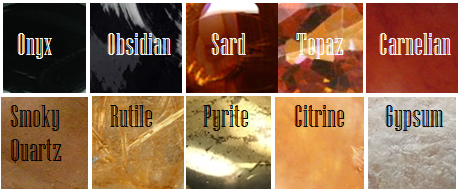
Pictured above: Onyx, Obsidian, Sard, Topaz, Carnelian, Smoky Quartz, Rutile, Pyrite, Citrine, Gypsum
These are trickier to use. As with some complex colors, the writer will have to get us to understand what most of these look like.
If you use these, or any more rare description, consider if it actually “fits” the book or scene.
Even if you’re able to get us to picture what “rutile” looks like, why are you using this description as opposed to something else? Have that answer for yourself.
“His skin reminded her of the topaz ring her father wore at his finger, a gleaming stone of brown, mellow facades.”
Physical Description
Physical character description can be more than skin tone.
Show us hair, eyes, noses, mouth, hands…body posture, body shape, skin texture… though not necessarily all of those nor at once.
Describing features also helps indicate race, especially if your character has some traits common within the race they are, such as afro hair to a Black character.
How comprehensive you decide to get is up to you. I wouldn’t overdo it and get specific to every mole and birthmark. Noting defining characteristics is good, though, like slightly spaced front teeth, curls that stay flopping in their face, hands freckled with sunspots…
General Tips
Indicate Race Early: I suggest indicators of race be made at the earliest convenience within the writing, with more hints threaded throughout here and there.
Get Creative On Your Own: Obviously, I couldn’t cover every proper color or comparison in which has been “approved” to use for your characters’ skin color, so it’s up to you to use discretion when seeking other ways and shades to describe skin tone.
Skin Color May Not Be Enough: Describing skin tone isn’t always enough to indicate someone’s ethnicity. As timeless cases with readers equating brown to “dark white” or something, more indicators of race may be needed.
Describe White characters and PoC Alike: You should describe the race and/or skin tone of your white characters just as you do your Characters of Color. If you don’t, you risk implying that White is the default human being and PoC are the “Other”).
PSA: Don’t use “Colored.” Based on some asks we’ve received using this word, I’d like to say that unless you or your character is a racist grandmama from the 1960s, do not call People of Color “colored” please.
Not Sure Where to Start? You really can’t go wrong using basic colors for your skin descriptions. It’s actually what many people prefer and works best for most writing. Personally, I tend to describe my characters using a combo of basic colors + modifiers, with mentions of undertones at times. I do like to veer into more creative descriptions on occasion.
Want some alternatives to “skin” or “skin color”? Try: Appearance, blend, blush, cast, coloring, complexion, flush, glow, hue, overtone, palette, pigmentation, rinse, shade, sheen, spectrum, tinge, tint, tone, undertone, value, wash.
Skin Tone Resources
List of Color Names
The Color Thesaurus
Skin Undertone & Color Matching
Tips and Words on Describing Skin
Photos: Undertones Described (Modifiers included)
Online Thesaurus (try colors, such as “red” & “brown”)
Don’t Call me Pastries: Creative Skin Tones w/ pics I
Writing & Description Guides
WWC Featured Description Posts
WWC Guide: Words to Describe Hair
Writing with Color: Description & Skin Color Tags
7 Offensive Mistakes Well-intentioned Writers Make
I tried to be as comprehensive as possible with this guide, but if you have a question regarding describing skin color that hasn’t been answered within part I or II of this guide, or have more questions after reading this post, feel free to ask!
~ Mod Colette
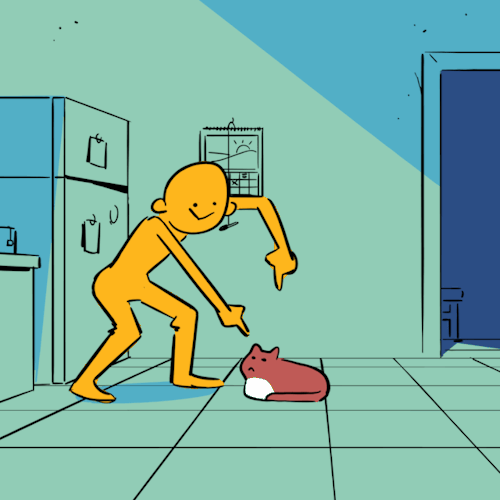
Bothering the beast
collection of useful things tumblr has taught me:
even if you can't fall asleep, laying down with your eyes closed will still rest your body
you don't have to brush your teeth standing up
you don't have to do any chore standing up, from dishes to showering
you don't have to shower with the lights on
if you can't brush your teeth, flossing and a tongue scraper gets rid of plaque and bad breath
if you can't do that, mouthwash kills a lot of bacteria
eating "unhealthy" food is better than eating no food
you can make the same meal everyday for however long you still want it
some pills come in syrups or chewables if you can't swallow them
kids nutritional shakes can be a quick way to get fuel if you can't eat/don't have time
if walking hurts/exhausts you on a regular basis, canes and rollers are for you, no matter how young you are
we have free will—if doing something "out of the ordinary" makes life easier for you, do it

Well done, Ireland! <3






tutorial for drawing characters with cleft lip! sorry that it's mostly unilateral-centric but it makes up the vast majority of resources and photos. still tried to get tips for drawing bilateral clefts in though.
please keep in mind that this is an introductory drawing tutorial and has some generalizations in it, so not every “X is Z” statement will be true for Actual People : )
if you draw any characters using this feel free to tag me!!

Staff have done their best to hide this post, OP's blog has been deleted to hide it. Spread this post as much as you can (ideally through screenshots to avoid it being nuked)

deleted scene from long shadows

Moon 11: Life going on
-
 calicotomcat reblogged this · 1 week ago
calicotomcat reblogged this · 1 week ago -
 stonefrogz reblogged this · 1 week ago
stonefrogz reblogged this · 1 week ago -
 dangerousangelengineer liked this · 1 week ago
dangerousangelengineer liked this · 1 week ago -
 mustardyellowlilac reblogged this · 1 week ago
mustardyellowlilac reblogged this · 1 week ago -
 princess-cinnabuns reblogged this · 1 week ago
princess-cinnabuns reblogged this · 1 week ago -
 daddy-cado reblogged this · 1 week ago
daddy-cado reblogged this · 1 week ago -
 kirionabrainrot reblogged this · 1 week ago
kirionabrainrot reblogged this · 1 week ago -
 ninto55 liked this · 1 week ago
ninto55 liked this · 1 week ago -
 sigh-idiots reblogged this · 1 week ago
sigh-idiots reblogged this · 1 week ago -
 secretlovesoftheheart reblogged this · 1 week ago
secretlovesoftheheart reblogged this · 1 week ago -
 salmon404 liked this · 1 week ago
salmon404 liked this · 1 week ago -
 milliesoftpaws reblogged this · 1 week ago
milliesoftpaws reblogged this · 1 week ago -
 the-kazoo-kid reblogged this · 1 week ago
the-kazoo-kid reblogged this · 1 week ago -
 the-kazoo-kid liked this · 1 week ago
the-kazoo-kid liked this · 1 week ago -
 shores-of-oblivion liked this · 1 week ago
shores-of-oblivion liked this · 1 week ago -
 mmmmwaffles94 reblogged this · 1 week ago
mmmmwaffles94 reblogged this · 1 week ago -
 celestial-seasonings-sleepytime reblogged this · 1 week ago
celestial-seasonings-sleepytime reblogged this · 1 week ago -
 crypticspyder reblogged this · 1 week ago
crypticspyder reblogged this · 1 week ago -
 crypticspyder liked this · 1 week ago
crypticspyder liked this · 1 week ago -
 zoof-reblog reblogged this · 1 week ago
zoof-reblog reblogged this · 1 week ago -
 sharkenthusiast reblogged this · 1 week ago
sharkenthusiast reblogged this · 1 week ago -
 buttsbotyaasssss reblogged this · 1 week ago
buttsbotyaasssss reblogged this · 1 week ago -
 cinnamonteo reblogged this · 1 week ago
cinnamonteo reblogged this · 1 week ago -
 somewhereinasgard reblogged this · 1 week ago
somewhereinasgard reblogged this · 1 week ago -
 ghostof1705 reblogged this · 1 week ago
ghostof1705 reblogged this · 1 week ago -
 soup-4-life reblogged this · 1 week ago
soup-4-life reblogged this · 1 week ago -
 gooseinboots liked this · 1 week ago
gooseinboots liked this · 1 week ago -
 camdennightingale reblogged this · 1 week ago
camdennightingale reblogged this · 1 week ago -
 camdennightingale liked this · 1 week ago
camdennightingale liked this · 1 week ago -
 samusreader reblogged this · 1 week ago
samusreader reblogged this · 1 week ago -
 vamparchy reblogged this · 1 week ago
vamparchy reblogged this · 1 week ago -
 lokidokeyartichoki reblogged this · 1 week ago
lokidokeyartichoki reblogged this · 1 week ago -
 chaoticbooklesbian reblogged this · 1 week ago
chaoticbooklesbian reblogged this · 1 week ago -
 the-fandom-hopping-mage liked this · 1 week ago
the-fandom-hopping-mage liked this · 1 week ago -
 the-fandom-hopping-mage reblogged this · 1 week ago
the-fandom-hopping-mage reblogged this · 1 week ago -
 great-exhibition-of-1851 reblogged this · 1 week ago
great-exhibition-of-1851 reblogged this · 1 week ago -
 summerlimeismethebrony reblogged this · 1 week ago
summerlimeismethebrony reblogged this · 1 week ago -
 entropychaos liked this · 1 week ago
entropychaos liked this · 1 week ago -
 leftemperor liked this · 1 week ago
leftemperor liked this · 1 week ago -
 prettylynnpup liked this · 1 week ago
prettylynnpup liked this · 1 week ago -
 joleneboquila reblogged this · 1 week ago
joleneboquila reblogged this · 1 week ago -
 wall2468 reblogged this · 1 week ago
wall2468 reblogged this · 1 week ago -
 die1kdeaths liked this · 1 week ago
die1kdeaths liked this · 1 week ago -
 catkittycatcatkittycatcatkitty reblogged this · 1 week ago
catkittycatcatkittycatcatkitty reblogged this · 1 week ago -
 biohorror-human liked this · 1 week ago
biohorror-human liked this · 1 week ago -
 ella-melon liked this · 1 week ago
ella-melon liked this · 1 week ago -
 thegreatgalacticking liked this · 1 week ago
thegreatgalacticking liked this · 1 week ago -
 parascleo reblogged this · 1 week ago
parascleo reblogged this · 1 week ago -
 parascleo liked this · 1 week ago
parascleo liked this · 1 week ago -
 superficial-lamb liked this · 1 week ago
superficial-lamb liked this · 1 week ago

Here to say random shit and draw random shit :D Pronouns are They/Them/She
141 posts
